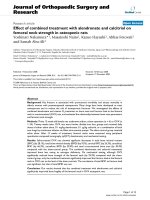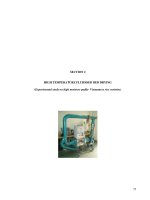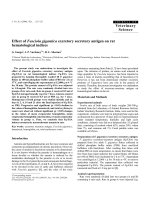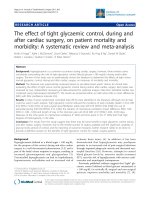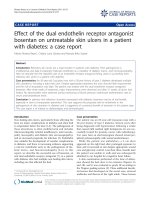Effect of Surfactant on Degradation of Polycyclic Aromatic Hydrocarbons (pahs) in Thermophilic Anaerobic Co-Digestion of Sludge from Kim-Ngưu River and Organic Waste
Bạn đang xem bản rút gọn của tài liệu. Xem và tải ngay bản đầy đủ của tài liệu tại đây (181.71 KB, 7 trang )
VNU Journal of Natural Sciences and Technology, Vol. 30, No. 1 (2014) 36-42
36
Effect of Surfactant on Degradation of Polycyclic Aromatic
Hydrocarbons (pahs) in Thermophilic Anaerobic Co-Digestion
of Sludge from Kim-Ngưu River and Organic Waste
Cao Vũ Hưng
1,
*, Bùi Duy Cam
1
, Bạch Quang Dũng
2
1
VNU University of Science, 334 Nguyễn Trãi, Hanoi, Vietnam
2
Vietnam Institute of Meteorology, Hydrology and Environment
Received 05 December 2013
Revised 19 December 2013; accepted 30 December 2013
Abstract: The aim of this study was evaluate the effect of nonionic surfactant (Tween 80) on
degradability of PAH compounds in thermophilic anaerobic co-digestion of sludge from Kim
Nguu river and organic waste. The simulation on laboratory scale was use for testing with 3/1 ratio
of organic waste and sludge. During experiment, the concentration of PAHs was measured by GC
FID method and its variation was paid more attention to evaluate its degradability.
The results showed that removal efficiency of 2-3 rings, 4 rings, 5 rings, 6 rings and total
PAHs compounds in the case of (Sludge + Organic waste) were 65.34%, 47.93%, 35.43%, 21.35%
and 22.83% respectively. The degradability of 2-3 rings compounds was higher over two times
than the 5 rings compounds and three times than the 6 rings compounds.
When using nonionic surfactant agent (Tween 80) with 0.5 g/l of concentration, the rate and
degradability of PAHs compounds increased significantly except 4 rings of PAHs which had not
identified in the influent of (SL + OW + Tween 80). Degradability of 2-3 rings PAHs compounds
increased from 65.34% to 83.98%, 5 rings compounds increased from 35.43% to 53.71%, 6 rings
compounds increased from 21.35% to 67.06% and total PAHs increased from 22.83% to 67.22%.
This result is basic for implement to study deeply enhancing degradability of PAHs
compounds in the sludge of Kim Nguu river to remove them from initial substrate in effort
applying end product for agricultural soil.
1. Introduction
∗
∗∗
∗
Polycyclic aromatic hydrocarbons (PAHs)
are formed during the incomplete combustion
of organic material or during pyrolysis
processes. Though they may have natural
origins, the main pollution sources for the
PAHs are anthropic (combustion of fossil
_______
∗
Corresponding author. Tel: 84-904442426.
E-mail:
materials, motor vehicle, industrial combustion,
smoke of cigarettes, etc.). This wide spectrum
of sources allows explaining their ubiquity in
the environment. They are carried out to
wastewater treatment plants by effluent
discharge and runoff waters. As they present
low solubility in water and are highly
lipophilic, they adsorb and accumulate in
sludge throughout the wastewater treatment [1-
5]. Moreover, the PAHs are highly toxic with
carcinogenic and mutagenic properties. They
C.V. Hưng et al. / VNU Journal of Natural Sciences and Technology, Vol. 30, No. 1 (2014) 36-42
37
are also persistent and are considered as priority
pollutants in the US EPA and EU lists. The
accumulation of polluted organic compounds
and heavy metals is causes difficulties to use
the municipal sewage sludge for agriculture [6, 7].
Currently, the research on anaerobic
digestion of PAHs compounds are mainly focus
on PAHs contaminated soil. It is not much the
work to study PAHs in the municipal sewage
sludge. In recent year, the anaerobic digestion
of PAHs compounds in sewage sludge was paid
more attention when the anaerobic method was
applied like solution for recover energy from
generated biogas.
Biodegradation of PAHs in sewage sludge
has high rate of success, but the kinetics of this
process is still not fully understood.
According
to (Haritash et al., 2009) [8] shown that the
degradation of PAHs depended on their
concentration in the sludge and strongly relative
to partition-coefficient of PAHs between water
phase and sludge phase. Therefore, sewage
sludge is pre-treated by heat or ozone before
anaerobic decomposition increases rate as well
as degradability of PAHs.
Currently, using surfactant to enhance
desorption and decomposition of PAHs from
sewage sludge is an effective method.
Surfactant agents effect on PAHs solubility and
pull them from sludge particles into elute and
enhance their decomposition. The surfactants
were used mainly nonionic substances such as
Tween 20, Tween 80, Triton X100 [9].
Investigation of (Zheng et al., 2007)[10] was
shown that using Tween-80 to increase removal
efficiency of total PAHs in sewage sludge from
54% to 60%.
Study the effect of nonionic surfactant
(Tween 80) on decomposition of PAHs
compounds in thermophilic anaerobic co-
digestion of sludge from Kim Nguu river and
organic waste was responsible for developing
method to treat sludge from Kim Nguu river
which one of the receiving urban wastewater
river in Hanoi city. Results of this study will
enhance developing treatment method for
municipal sludge in Hanoi city as well as in
overall system of urban waste management in
Vietnam.
2. Materials and methods
2.1. Experimental set up
The pilot equipment consists of single
cylindrical reactor (diameter 0.6m, height 0.8m)
made from stainless steel with available volume
is 40 liters.
The out site is heat keeping layer. The
reactor also is equipped with a thermal
insulation and the temperature is kept constant
at 55°C (thermophilic condition). Gas
volumetric flow measurement is used to
measure gas volume after 24 hour.
The effluent substrate was sampled
though valve in the bottom of reactor. The
scheme of method was shown at fig. 1.
Fig. 1. Scheme of method.
Analysis: CODt,
TS, VS, PAHs
Unaerobic bio
-
reactor
T
o
= 55
o
C
SL 30% Vol. + OW
70% Vol.
S
L
30% Vol. + OW
70% Vol. +
Tween 80 (0.5 g/l)
Mixing
Sampling
Mixing
C.V. Hưng et al. / VNU Journal of Natural Sciences and Technology, Vol. 30, No. 1 (2014) 36-42
38
2.2. Substrates characteristics
The anaerobic co-digestion included two
different substrates, the sludge was collected
from Kim Nguu River and the organic waste
was selected from market with composition can
be roughly estimated as 30% animal origin and
70% vegetable origin. The stones and inert
substance were removed from sludge by
sieving, organic waste was grinded and they
were mixed with one part of sludge and three
part of organic waste. According to (Cao &
Bui., 2013) [11] this ratio is suitable for bio-
degradation of Kim Nguu river sludge.
The composition influent substrate of two
experiments was shown in table 1.
Table 1. Input substrates composition
Parameters SL + OW
SL + OW
+ Tween 80
TS (%) 20.1
19.0
VS (% TS) 60.3
62.1
pH 7.33
7.54
EC 3530
3329
COD total 83590
79685
Tween 80 (g/l) 0
0.5
Heavy metals (mg/kg DS)
As 25.3
20.7
Cd 3.10
2.15
Cr 146
139
Ni 74.8
75.9
Cu 124
115
Pb 71
59.7
Zn 571
535
PAHs (mg/kg DS)
Naphthalene 0.55
0.67
Acenaphthylene 1.76
1.65
Acenaphthene 0
0.83
Fluorene 1.52
2.67
Anthracene 0
2.16
Fluoranthene 0.40
0
Pyrene 0.60
0
Benz[b]fluoranthene 0.61
0
Benzo[k]fluoranthene 2.47
0
Benzo[a]pyrene 1.69
8.12
Indeno[1,2,3-cd]pyrene
60.4
54.9
Dibenz[a,h]anthracene 49.4
27.1
Benzo[ghi]perylene 57.7
67.7
Ʃ PAHs 177
166
SL: sludge; OW: organic waste;
2.3. PAHs extraction and analysis
The sludge samples were dried at 60
o
C, for
24 h, until it was completely dried. The exact
weights of the samples were recorded. After
grinding the sludge samples using a mortar,
extraction process was performed. 50 µl of d
10
-
phenanthrene solution (10-mg d
10
-phenanthrene
in 50 ml dichloromethane) was added to the
sample as a surrogate standard. The samples
were extracted two times using 40 ml of CH
2
Cl
2
in a tight Teflon tube under condition:
temperature 80°C, maximum pressure 350 psi,
retention time 20 minutes [12]. The supernatant
were decanted after each cycle of extraction and
then filtered through filter paper, sodium sulfate
power added to remove excess water. The
composite supernatants were evaporated using
rotary vacuum evaporator at 40
o
C, until sample
volumes were smaller than 1 ml. The samples
were fulfilled with dichloromethane to 2ml,
filtered through a PP-housing 0.45 µm syringe
filter (Minisart
RC 15) and stored in glass
vials sealed with Teflon-butyl rubber caps. The
samples were kept in refrigerator before GC
injection.
Residual concentration of 16 PAHs
compounds. PAHs samples were analyzed
using YL 6100 series gas chromatograph using
Agilent J&W Advanced Capillary GC column
HP-5 (30 m x 0.32 mm i.d.; film thickness 0.25
µm) and flame ionization detector (FID). A 2µl
aliquot of PAH sample was injected using an
auto-sampler. Nitrogen was used as the carrier
gas at a flow rate 2.5 ml/min. Inlet conditions
are split ratio 5:1, split flow 10ml/min, heater
200
o
C, pressure 11.5 psi. The starting
temperature was 150
o
C and the temperature was
ramped to 190
o
C at 8
o
C/min with 5 min
holding, ramped to 220
o
C at 2
o
C/min, ramped
to 300
o
C at 15
o
C/min, and then ramped to
C.V. Hưng et al. / VNU Journal of Natural Sciences and Technology, Vol. 30, No. 1 (2014) 36-42
39
310
o
C at 2
o
C/min with 2 min holding. Detector
conditions were heater 300
o
C, H
2
flow 36
ml/min, air flow 350 ml/min, and make up flow
30 ml/min.
2.4. Other analysis
COD total (CODt) was determined by
dichromate method titration; Humidity is
defined by drying at 105
o
C during 24 hours,
volatile solid (VS) is determined by burning dry
samples in ceramic cup at 550
o
C during 2 hours.
3. Results and discussions
Two experiments were implemented under
thermophilic anaerobic condition during three
months. The amount of CH
4
generated was
determined to be 320 ml/g VS degraded. TS
and VS removals were 15.4% and 18.2%
respectively, in the case of (SL + OW). In the
case of (SL +OW + Tween 80), CH
4
generated
was 351 ml/g VS degraded, TS and VS removal
were 13.51% and 18.3% respectively. This
phenomenon indicated that the system active
well in anaerobic condition and Tween 80 as
well as heavy metals composition in initial
substrate (table 1) do not effect on microbial
activities.
3.1. Sludge + Organic waste treatment
The bio-degradation of PAHs in case of (SL
+ OW) was shown in fig. 2, 3. The removal
efficiency of 2-3 rings, 4 rings, 5 rings, 6 rings
and total PAHs compounds were 65.34 %,
47.93 %, 35.43 %, 21.35 % and 22.83 %
respectively. The bio-degradability of 2-3 rings
compounds was higher over two times than the
5 rings compounds and three times than the 6
rings compounds. Bio-degradation ability of 5,
6 rings compounds were lower than 2-3, 4 rings
compounds due to their strong hydrophobicity
which makes them less bioavailability [13]. The
degradation rate of 2-3 rings, 4 rings compound
more rapid during the first 18 days of
decomposition process, this phenomenon is
similar to the study of [10, 14, 15] which
indicate that the bio-degradation kinetic of low
molecular weight depends on their initial
concentration.
0
20
40
60
80
100
0 5 11 17 27 36 43 55 61 71 79 87
Time (days)
PAHs removal (%)
2-3 rings
4 rings
5 rings
6 rings
Ʃ PAHs
Fig. 2. Time variation of the PAH degradation in the
case of (SL + OW).
0
20
40
60
80
100
2-3 Rings 4 Rings 5 Rings 6 Rings Ʃ PAHs
PAHs
PAHs removal (%)
% PAHs removal
Fig. 3. PAHs removal yields in the case of (SL +
OW) relation to the number of aromatic rings.
3.2. Sludge+Organic waste+Tween 80 treatment
In case of (SL + OW + Tween 80) is similar
to the case of (SL + OW), degraded rate is rapid
within the first 18 days (fig. 4). When using
nonionic surfactant agent (Tween 80), the rate
and degradability of PAHs compounds also
increased significantly except 4 rings of PAHs
which had not identified in the influent of (SL +
C.V. Hưng et al. / VNU Journal of Natural Sciences and Technology, Vol. 30, No. 1 (2014) 36-42
40
OW + Tween 80) (table 1). Degradability of 2-3
rings PAHs compounds increased from 65.34%
to 83.98%, 5 rings compounds increased from
35.43% to 53.71%, 6 rings compounds
increased from 21.35% to 67.06% and total
PAHs increased from 22.83% to 67.22% (fig. 5).
As for the 5 rings PAHs compounds has
differences between two experiments, the
decomposition of 5 rings PAHs compounds was
faster than 6 rings compounds in the case of (
SL + OW ) (fig. 2 ), this result is suitable to
study of [13]. However, using Tween 80 in the
case of (SL + OW + Tween 80) made
degradability of 6 rings PAHs compounds
increase more than 5 rings compounds (fig. 4),
this phenomenon can be proved that the
concentration of 5 rings compounds in influent
was too lower than 6 rings compounds (table 1).
The surfactant agent made 6 rings compounds
dissolved more in the water phase which
enhances their ability to decompose. In the
study of [10], when used Tween 80 to enhanced
decomposition of PAHs in sewage sludge has
resulted in 2, 3, 4 rings of PAHs compound but
5, 6 ring compounds the results was unclear.
However, in the case of this research, the
experiment was carried out for long periods in
high temperature with optimum agitation
conditions which enhanced significantly the
decomposition of 5, 6 ring PAH compounds.
0
20
40
60
80
100
0 5 11 17 27 36 43 55 61 71 79 87
Time (days)
PAHs removal (%)
2-3 rings
5 rings
6 rings
Ʃ PAHs
Fig. 4. Time variation of the PAHs degradation in
the case of (SL + OW + Tween 80).
0
20
40
60
80
100
2-3 rings 5 rings 6 rings Ʃ PAHs
PAHs
PAHs removal (%)
SL+OW
SL+OW+Tween 80
Fig. 5. Final PAHs removal yields after different
thermophilic anaerobic treatments in relation to the
number of aromatic rings
.
4. Conclusions
The study showed the degradability of
PAHs in thermophilic anaerobic co-digestion of
sludge in Kim Nguu river and organic waste
with three part of organic waste per one part of
sludge ratio. The removal efficiency of 2-3
rings, 4 rings, 5 rings, 6 rings and total PAHs
compounds were 65.34%, 47.93%, 35.43%,
21.35% and 22.83% respectively. The bio-
degradability of 2-3 rings compounds was
higher over two times than the 5 rings
compounds and three times than the 6 rings
compounds.
When using nonionic surfactant agent
(Tween 80), the degradability of PAHs
compounds also increased significantly except
4 rings of PAHs which had not identified in the
influent of (SL + OW + Tween 80).
Degradability of 2-3 rings PAHs compounds
increased from 65.34% to 83.98%, 5 rings
compounds increased from 35.43% to 53.71%,
6 rings compounds increased from 21.35% to
67.06% and total PAHs increased from 22.83%
to 67.22%.
C.V. Hưng et al. / VNU Journal of Natural Sciences and Technology, Vol. 30, No. 1 (2014) 36-42
41
This result is basic for implement to study
deeply enhancing degradability of PAHs
compounds in the sludge of Kim Nguu river to
remove them from initial substrate in effort
applying end product for agricultural soil.
References
[1] S. Perez, M. Guillamon, D. Barcelo,
Quantitative analysis of polycyclic aromatic
hydrocarbons in sewage sludge from
wastewater treatment plants, Journal of
Chromatography A 938 (2001) 57-65.
[2] S.R. Wild, S.P. McGrath, K.C. Jones, The
polynuclear aromatic hydrocarbon (PAH)
content of archived sewage sludges.
Chemosphere 20 (1990) 703-716.
[3] F. Busetti, A. Heitz, M. Cuomo, S. Badoer, P.
Traverso, Determination of sixteen polycyclic
aromatic hydrocarbons in aqueous and solid
samples from an Italian wastewater treatment
plant, J. Chromatography. A 1102 (2006) 104-
115.
[4] Q.Y. Cai, C.H. Mo, Q.T. Wu, Q.Y. Zeng, A.
Katsoyiannis, Occurrence of organic
contaminants in sewage sludges from eleven
wastewater treatment plants, China,
Chemosphere 68 (2007) 1751-1762.
[5] W. Yan, J. Chi, Z. Wang, W. Huang , G. Zhang,
Spatial and temporal distribution of polycyclic
aromatic hydrocarbons (PAHs) insediments
from Daya Bay, South China, Environmental
Pollution 157 (2009) 1823-1830.
[6] P. Villar, M. Callejon, E. Alonso, J.C. Jimenez,
A. Guiraum, Temporal evolution of polycyclic
aromatic hydrocarbons (PAHs) in sludge from
wastewater treatment plants: Comparison
between PAHs and heavy metals, Chemosphere
64 (2006) 535-541.
[7] S. Khadhara, T. Higashi, H. Hamdi, S.
Matsuyama, A. Charef, Distribution of 16 EPA-
priority polycyclic aromatic hydrocarbons
(PAHs) in sludges collected from nine Tunisian
wastewater treatment plants, Journal of
Hazardous Materials 183 (2010) 98-102.
[8] A.K. Haritash, C.P. Kaushik, Biodegradation
aspects of Polycyclic Aromatic Hydrocarbons
(PAHs): A review, Journal of Hazardous
Materials 169 (2009) 1-15
[9] Bach Quang Dung, Enhancement of intrinsic
bioremendiation of PAHs-contaminated anoxic
estuarine sediment by the addition of
biostimulating agents, Master thesis, Myongij
University Korea (2004).
[10] X.J. Zheng, J.F. Blais, G. Mercier, M.
Bergeron, P. Drogui, PAH removal from spiked
municipal wastewater sewage sludge using
biological, chemical and electrochemical
treatments, Chemosphere 68 (2007)1143-1152.
[11] Cao Vu Hung & Bui Duy Cam, Thermophilic
anaerobic co-digestion of source selected
organic waste and municipal sewage sludge.
Case study in Hanoi, Vietnam Journal of
chemistry 51(2) (2013) 213-217.
[12] I.J. Barnabas, J.R. Dean, I.A. Fowlis, S.P.
Owen, Extraction of Polycyclic Aromatic
Hydrocarbons from highly contaminated soil
using micro-way energy, Analyst, Vol. 120
(1995) 1897-1904.
[13] A.B. Martinez, H. Carrere, D. Patureau, J.P.
Delgenes, Ozone pre-treatment as improver of
PAH removal during anaerobic digestion of
urban sludge, Chemosphere 68 (2007) 1013-
1019.
[14] C. Lors, D. Damidot, J.F. Ponge, F. Perie,
Comparison of a bioremediation process of
PAHs in a PAH-contaminated soil at field and
laboratory scales, Environmental Pollution 165
(2012) 11-17.
[15] J. Dou, X. Liu, A. Ding, Anaerobic degradation
of naphthalene by the mixed bacteria under
nitrate reducing conditions, Journal of
Hazardous Materials 165 (2009) 325-331.
C.V. Hưng et al. / VNU Journal of Natural Sciences and Technology, Vol. 30, No. 1 (2014) 36-42
42
Tác dụng của chất hoạt động bề mặt lên sự phân hủy hợp chất
hữu cơ đa vòng thơm (PAHs) của bùn thải tại sông Kim Ngưu
trong quá trình ổn định kết hợp rác hữu cơ bằng phương pháp
lên men yếm khí nóng
Cao Vũ Hưng
1
, Bùi Duy Cam
1
, Bạch Quang Dũng
2
1
Trường Đại học Khoa học Tự nhiên, ĐHQGHN, 334 Nguyễn Trãi, Hà Nội, Việt Nam
1
Viện Khoa học Khí tượng Thủy văn và Môi trường
Tóm tắt: Nghiên cứu nhằm đánh giá tác dụng của chất hoạt động bề mặt không phân cực Tween
80 lên sự phân hủy của một số hợp chất hữu cơ đa vòng thơm (PAHs) có trong bùn thải sông Kim
Ngưu trong quá trình ổn định kết hợp với rác hữu cơ bằng phương pháp lên men yếm khí nóng.
Nghiên cứu sử dụng mô hình qui mô phòng thí nghiệm để tiến hành ổn định bùn thải và rác hữu cơ với
tỷ lệ theo thể tích 3 rác/1 bùn. Trong suốt thời gian thí nghiệm, mẫu hỗn hợp phản ứng được lấy định
kỳ và hàm lượng PAHs trong sinh khối được xác định bằng phương pháp sắc ký khí kết hợp detector
ngọn lửa (GC FID). Sự thay đổi của hàm lượng PAHs trong sinh khối theo thời gian là cơ sở để đánh
giá khả năng phân hủy của các hợp chất PAHs.
Trong trường hợp không sử dụng chất hoạt động bề mặt, nghiên cứu đã chỉ ra rằng khả năng phân
hủy của các hợp chất 2-3 vòng, 4 vòng, 5 vòng, 6 vòng và tổng PAHs lần lượt là 65.34%, 47.93%,
35.43%, 21.35% and 22.83%. Sự phân hủy của các hợp chất 2-3 vòng lớn hơn 2 lần so với các hợp
chất 5 vòng và hơn 3 lần so với các hợp chất 6 vòng.
Khi sử dụng Tween 80 với hàm lượng 0,5 g/l, khả năng phân hủy các hợp chất PAHs đã tăng lên
một cách rõ rệt. Ngoại trừ các hợp chất 4 vòng thơm không phát hiện trong nguyên liệu đầu vào, các
hợp chất 2-3 vòng tăng khả năng phân hủy từ 65.34% lên đến 83.98%, các hợp chất 5 vòng tăng từ
35.43% lên 53.71%, hợp chất 6 vòng tăng từ 21.35% lên 67.06% và tổng PAHs tăng từ 22.83% lên
67.22%.
Kết quả nghiên cứu là cơ sở để tiến hành các nghiên cứu sâu hơn về sự phân hủy của các hợp chất
PAHs trong bùn thải tại sông Kim Ngưu cũng như bùn thải đô thị nói chung nhằm loại bỏ các tác nhân
ô nhiễm độc hại để có thể sử dụng sản phẩm sau xử lý trong cải tạo đất nông nghiệp.


